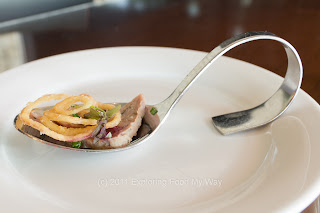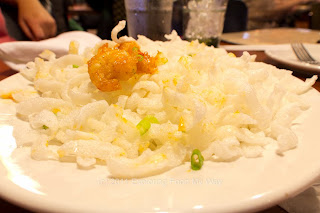Of the restaurants listed, I ate at Club Isabella only once and didn't manage to get to the Baricelli Inn until after I had graduated college and was actually making money. Sadly, That Place On Bellflower and Club Isabella closed down many years ago. That Place was eventually reborn as L'Albatros Brasserie. Recently, I learned that under the direction of Chef Fabio Mota, Club Isabella was also to reopen, and while technically not in the same spot as the original, it was still situated on Case's campus.
The new incarnation was located at 2175 Cornell Road, Cleveland, OH 44106 and can be reached at 216-229-1111. Having been open for several months now, I decided to go on a Tuesday evening to check them out. As I pulled to the corner of Cornell and Random Roads, I caught my first glimpse of the newly revamped corner space:

Street parking was available, but for only $3, I could valet the car. No brainer there. The patio in the picture above was available for service, but since I was expecting a friend for dinner and didn't want to compete with outside noises (such as the metro train line that runs on the opposite side of Random Road), I opted to sit inside instead. I should mention that the front door to the restaurant was at the far right side of all of those windows. It wasn't particularly obvious and it took me a second or two to realize where it was.
Once inside, the host politely greeted me and because the restaurant wasn't busy that night, allowed me to choose the table at which I'd like to sit. Picking a nice, large four-top by the front window, he left me with the dinner menu:


Within just a few minutes, my server arrived to take my order. I had read about some of the dishes offered on the menu prior to my visit tonight and was eager to try some of them for myself.
The first surprise to come out of the kitchen was a complimentary amuse bouche, lamb terrine with cherry jam and fried shallots:

This was a very tasty way to start the meal. The lamb almost had that gyro meat taste to it. The cherry jam was a bit hidden in flavor, and I think provided a bit of underlying acidity more than its own flavor. I was definitely looking forward to more from the kitchen.
Next up on the table was a small dish of softened, herbed butter:

And fresh bread, in this case a piece from an Epi:

Both were fresh and delicious. While I did try the herbed butter on a piece of the bread, I mostly ate the bread unadorned. Good bread doesn't need a topper and this one definitely fit the bill of good bread.
Having had my one bite amuse and nibbled on some of the bread, I was ready and waiting for my appetizer course to arrive, Sweet and Spicy Fried Cuttlefish:

This was one of the dishes I had read about before coming to Club Isabella and it wholly intrigued me. I have never eaten cuttlefish before, but I know that it is just another encephalopod, like squid or octopus, both of which I have enjoyed in the past. Visually, the plate was quite stunning and I eagerly dove in. The wait was totally worth it.
The cuttlefish itself was soft and tender and yet had just a bit of chew to it. I imagine that cuttlefish is as temperamental as its cousins and cooking it too little or too much would render it chewy beyond recompense. The sauce coating the cuttlefish was indeed both sweet and slightly spicy. For those who abhor spice, it might have been too much. I completely enjoyed it. The red peppers, scallions, and sesame seeds added additional notes of flavor and texture.
Two things to note, however. First, this was an appetizer that could easily be shared by two or more people. Second, and I didn't realize this until I had gotten home and was processing my photos on my large computer monitor, if you look closely at the picture towards the bottom front of the pile of cuttlefish, there is a long black hair in the dish. I didn't see it at the restaurant (or I would have sent it back to be re-fired) and I have no idea if I even ingested it. I contacted the chef the next day to explain what I had found and his response was:
"Thomas.....sorry about that! We in the kitchen all have very very short hair so I can't imagine how it got there but let me know the next time you are in and I'll set you up!"
Take that for what it's worth.
Following my appetizer course, the salad course, an Arugula and Ridicchio Salad, arrived promptly:

Topped with almonds, an onion marmalada, and Lake Erie Creamery chevre, the salad had that wonderful mix of pepperiness from the arugula and bitterness from the ridicchio. The almonds added a nice crunch to the salad and the onion marmalada a touch of sweetness. The only thing that didn't work for me was the goat cheese. By itself, it was lovely. But one of the characteristics of Lake Erie Creamery's chevre is its mild tanginess. The delicate flavor got completely lost against the bolder, stronger flavors of the other ingredients in the dish.
Until this point in the meal, courses had been coming out of the kitchen fairly promptly. Suddenly, between the salad course and the entree, the length of time lengthened considerably. It wasn't so much that I had any place to be, but the shift was noticeable. When my server finally approached my table empty handed, I knew something was up. She apologized for how long it was taking and asked if I would like an intermezzo while I waited. Figuring that my order had either forgotten to get fired or that it had been improperly cooked and needed to be re-fired, I agreed.
Minutes later, she returned with a small dish of Jenis Cherry Lambic Sorbet with a sprig of fresh thyme:

I've already written at length about my love of Jenis ice creams and sorbets, so I won't belabor the point here except to say that this was a delicious and refreshing way to segue from previous courses to the next.
Finally, my entree arrived at the table, the Salt-Crusted Bronzini with Lemon and Chervil:

Dressed with olive oil and micro-greens, what surprised me most about the dish was that it was served whole, head and tail intact. While this doesn't bother me, per se, I know many people would be put off by such a presentation. That said, I was looking forward to how moist the fish would be due to the salt-crust treatment. As I took my first bite, I enjoyed the simplicity of flavors, the tenderness of the flesh, and the slight anise flavor provided by the chervil. While the fish was moist, it didn't quite hit the level of moistness I was expecting. Don't get me wrong, it wasn't bad by any stretch of the imagination. But it wasn't that perfect "10" either.
Since the bronzini didn't come with a side, I decided to order my own, the Brussels Sprouts Gratin:

Just like the appetizer, the sides are meant to be shared. This was way more than I could finish alone (not to mention the fact that I had already eaten so much prior to this). The Brussels sprouts were topped with bacon and bleu cheese and then baked in this very cute enameled crock. While certainly tasty, the Brussels sprouts were cooked a little under al dente, and if you like your vegetables cooked all the way through, this might not be the side for you.
Amazingly, even after all of this food, when my server brought up the idea of dessert, I figured I would at least listen to the list of made in-house desserts (as opposed to the pastas, of which none were made in-house ... odd). When she arrived at the Lemon Tart, I figured that this would be the perfect way to end the meal.
By now, the sun had set and while I was full, I figured a bite or two of something nice and tart would be a great way to cleanse my palate. As with previous courses in tonight's meal, I should've realized that the dessert could've also been split between two people:

This was a lemon tart with strawberry sauce, toasted and ground nuts, a quenelle of freshly whipped vanilla scented cream, all topped with a sprig of mint. As I've gotten older, I've come to appreciate the restraint of a pastry chef who uses less sugar and allows other flavors, like the tartness of lemon to shine through. Sadly, between the strawberry sauce and the lemon curd, it was a tad too sweet for me. The other components of the dish, however, were simply marvelous.
To accompany my sweet dessert, I paired it with an unsweetened espresso:

This definitely hit the spot and helped to balance out the sweetness from the dessert. I would highly recommend pairing these two together.
Having only had water to drink during my meal, in the end, my check with tax came to $58. While that does seem pricey, since the appetizer, side dish, and dessert could have easily been split between two people, were you to add in a second entree for an additional diner, you would be looking at an $80 check for two people, which isn't terrible for this level of cuisine. Unfortunately, like the original Club Isabella, this food is still not really accessible to the poor college students that walk by the restaurant on a daily basis. Then again, when mom and dad come into town for a visit, this would definitely be a place I'd recommend going.
There were a few issues with my meal tonight, but overall, I enjoyed myself during my inaugural visit to the reopened Club Isabella. Assuming that the hair incident was an isolated occurrence, I have no hesitations recommending you check out Club Isabella next time you are in the area.








